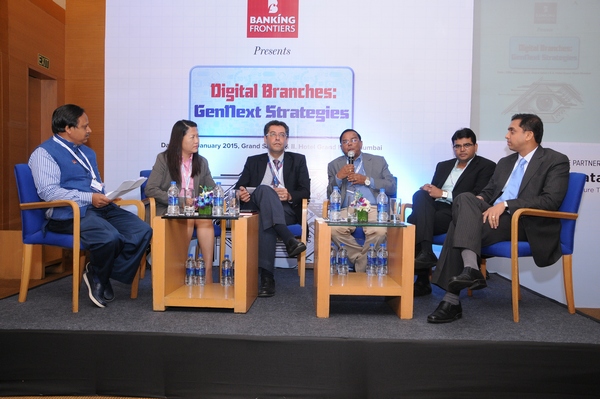
Panelists (from left to right): Manoj Agarwal, Monica Lim, Aspy Engineer, Lalit Sinha, Bharat Panchal and Arun Nair)
Aspy Engineer, Sr President & Country Head – ATM Management & Currency Chest, Yes Bank
Lalit Sinha, Head-Alliances and Partnerships, FSS & ex-GM of Union Bank of India.
Bharat Panchal, CISO at NPCI,
Monica Lim, Head-Issuance-APAC, Entrust Datacard
Arun Nair, Head-Campaigns and Channel Services, Axis Bank
Lalit: We are living in interesting times. The technology as we speak keeps on changing. the challenge is not implementing technology at all. I have seen all forms of branch transofmration in India- Baroda next, Union Next. Most banks started with a lobby site, the next revolution then was Citi and ICICI bank- 24×7 smart and electronic banking. The latest is SBI intouch, I have gone through SBI intouch and experienced it myself. Technology has never been a challenge, in early 1990s, the Citibank in Australia implemeted a video center in Australia, that was full of gadgets, and it was purely unassisted, and remote-acessed from miles away. That was an excellent implementation well ahead of time, and it unfortunately failed miserably. There can be many reasons of failure for such a brilliant implementation. The intention was great, tech-utilization was great. The same is good for SBI InTouch, and they should be complimented for the implementation. If the bank can implement touch, wave, voice and also add a tap n pay, then I dont think technology is a challenge.
Nair:On the UI front, one has to decide who is competition and what customer needs. Am I supposed to replicate a flipkart or a bigbasket? Or does the customer want a simple functionality. The other challenge is how to interface these new solutions with legacy systems. How do we bridge the gap between user experience and legacy systems. The next layer of challenge is to show RoI out of such initiatives. Most of the times, there are conventional products stuck on wall, and offered to customers, but in the backend it has to be connected and such offline initiatves are not fully in place. Within 30 days we have to come up with prototypes, and one does not know which one may work. There is point of cost amplification too. The difficulty is choosing if customer want to shop on banking site, or does he want us to only process his transaction.
Aspy: At a retail conference, there was a questions- moving from tellers to retailers. Are we moving from a teller experience to a retailing experience that the customer wants in the branch? Are we purely there just to service him? But there has to be a movement to move things innovatively. The customer needs and omnichannel presence has to be fulfilled, whether account opening, or any banking transaction. Customer wants peace of mind, and ease of mind to do his transactions- at his own location, at his own pace, and we have to ensure that there is adequate control to such things. Banking is heavily controlled and we have to ensure that we stay within regulations. We do have arguments about RoI, there are some intangibles such as Brand recognition too that are earned in such projects. Other RoI such as customer acquisition follows over a period of time.
Monica: We had the honor of working with many banks. Banks are sourcing innovative means to reach out to their customers. We take these ideas and brainstorm on how we can intelligently work with them. We then build a roadmap- which includes ROI, costs, technology frameworks, and then we execute it. In terms of technology, it can be easy to implement. The beauty of what we deliver can be implemented in stages. The CMO’s idea can be different from that of the CIO, the CTO and the CFO. The business units want more customerrs, and revenue, and the IT and audit teams want security- that adheres to the central banks and the organizations regulation. So, different departments come with different expectations, which can be challenging, however since we work in parts and stages, that is easily addressed too.
Bharat: I ave seen a concept 2-3 years ago in lebanon, you go to the last room of a bank branch, and get a customized and personalized debit card within 5 minutes. For India doing this is not impossible at all. The important thing that we are missing today is should we simply replicate what the other person is doing? If GPS does not work, I dont know how many Americans will actually find their house. We need to come out of a “copy” syndrome. If something works elsewhere, it can work here too is a negative mindset. While we speak about flipkart, No one has seen the flip side- the amount of frauds have risen, no one has seen the lacunae of technology. I think nothing would come to save the customer if he gives out his banking details elsewhere. Technology advancement is necessary, but we need to spend money, time and energy on customer education too.
Monica: Myanmar is at the forefront of banking revolution. A banker from Myanmar states that he wants to issue 1 bn cards. He is willing to invest in future. Banks should plan a roadmap and invest for a future. This is what SBI is achieving too. Customer education is also an important aspect that banks should invest in.
Nair: Customers are leapfrogging to mobiles directly from ATM, we hence skipped many lessons on the internet banking side. The customer’s experience of mobile is still applying to mobile apps of banks, this is where the anomaly is generated. Banks have to ensure that processes are secure, but secure enough that customers are still able to transact with speed.
Lalit:Let us look beyond security and have simpler authentication measures. Security is not a roadblock, it will not come in the way of digitizing.
Aspy:Instant issuance can be a good area to consider for replacement of cards lost, so that the customer is shared with a new card instantly.
Monica: We have customers that start with going for a single value proposition. The beauty is not to go all at it once, but slowly understand the market, understand customer base, and then add on new services. In some of our customer programs, banks are working with new customer designs, get a gallery of images, or preferred photos online or come in and choose. SBI is more of a shop front in a mall. This is an innovative way, and new representation of the branch.
Lalit: The death of the branch is not imminent, traditional ones have to go to the next one. Like the branch in a mall, in a coffee shop, banks should be present where the customer is located.
Aspy:the branch size is reducing but the efficiency is increasing. There is digitization, there are more tellers, bunchnote acceptors, cash recyclers, The profitability increases and the digital strategies would work. Its right now just compressed and packaged in one pack.
Nair: Customers prefer electronic channels. Earlier a lot of cross-selling was done through the branches, but with customer preferances increasing on the website and online mediums, the cross-selling initiatives are also being built online.
Bharat: NPCI has invested resources, and has an ability to capture real time data. We have entire customer history. The entire profiling has been done. For any card, frauds are restricted to metros and tier A cities. The likelihood of these going to rural is high, however in the instance when all customer details are shared with a fraudster, there is no technology in the world that will solve the fraud except that of customer education angle.







